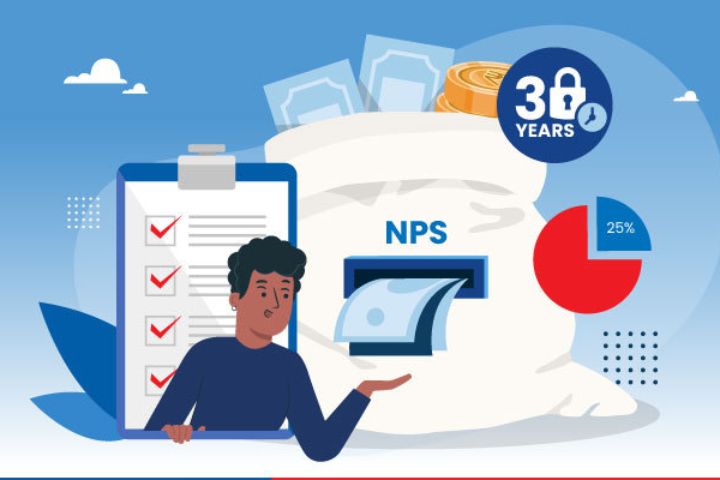NPS Calculator: How Your Contribution Frequency Affects Your Final Pension

In the current financial landscape, individuals are increasingly exploring retirement-focused investments that offer long-term returns, tax advantages, and stability. One such option that continues to stand out is the NPS scheme — or the National Pension System — a government-backed initiative designed to build a retirement corpus systematically. While the benefits of the scheme are widely known, what many investors often overlook is the role of contribution frequency and how it can significantly influence your retirement payout.
A useful way to estimate your future pension amount is by using an NPS calculator, which enables you to simulate different investment scenarios based on your contribution habits. This article explores how frequently you contribute to your NPS account can impact your final pension corpus and the associated annuity.
What Is the NPS Scheme?
The NPS scheme is a long-term, market-linked retirement savings tool regulated by the Pension Fund Regulatory and Development Authority (PFRDA). It allows Indian citizens aged between 18 and 70 years to invest in a mix of equity, corporate bonds, and government securities.
The scheme is structured into two tiers:
- Tier I: The mandatory retirement account with restrictions on withdrawals.
- Tier II: A voluntary investment account offering more liquidity.
Employees in the private and public sector, as well as self-employed professionals, can contribute to the NPS and benefit from its dual advantage — wealth accumulation and retirement income.
How the NPS Calculator Works
An NPS calculator is an online tool that helps you project your pension corpus and annuity based on several input parameters:
- Age at entry
- Monthly or annual contribution
- Expected rate of return
- Retirement age
- Percentage of the corpus to be annuitized
- Expected annuity rate
By adjusting these values, investors can visualise the impact of contribution amount and frequency on their retirement outcomes.
Most reputed private-sector banks, such as ICICI Bank, offer access to a free and intuitive NPS calculator on their website. These tools make it easier for customers to simulate their investments over the long term without the need for complex calculations.
Understanding Contribution Frequency in the NPS Scheme
While many investors focus on the contribution amount or fund allocation ratio, contribution frequency is a lesser-discussed factor that can significantly influence your pension benefits.
Here are the common modes of contribution:
- Monthly
- Quarterly
- Semi-Annually
- Annually
The minimum contribution requirement for Tier I is ₹1,000 per year, but there is no upper cap. You can contribute as many times as you like in a financial year.
How Contribution Frequency Impacts the Final Pension
Let’s explore how contribution frequency affects your pension using insights derived from a typical NPS calculator:
1. More Frequent Contributions = Higher Compounding Effect
When you contribute monthly instead of annually, each deposit gets a longer time to compound. Since the NPS is market-linked, early and frequent contributions benefit from market upsides over time.
For instance, investing ₹5,000 monthly for 30 years results in a higher corpus than investing ₹60,000 annually, even though the total yearly contribution is the same. This is due to the monthly investments enjoying more compounding cycles.
2. Better Cost Averaging
Frequent contributions help in averaging out the cost of units purchased. Market fluctuations can be better managed by spreading investments across different dates rather than investing in a lump sum once a year.
3. Flexibility During Market Volatility
Those who contribute quarterly or semi-annually may miss windows of market dips or peaks. A monthly contribution schedule offers more flexibility to respond to changes in market performance, thereby potentially improving long-term returns.
4. Behavioural Discipline
More frequent contributions cultivate disciplined savings habits. Monthly auto-debits or scheduled transfers through digital platforms like iMobile, available with ICICI Bank, encourage investors to stay consistent in their long-term planning.
Using the NPS Calculator to Compare Scenarios
To understand the impact of contribution frequency more clearly, consider the following example of two investors using an NPS calculator:
| Parameters | Investor A (Monthly) | Investor B (Annually) |
| Age at Entry | 30 | 30 |
| Retirement Age | 60 | 60 |
| Contribution | ₹5,000/month | ₹60,000/year |
| Expected Return Rate | 9% | 9% |
| Annuity % at Maturity | 40% | 40% |
| Expected Annuity Return Rate | 6% | 6% |
Using a standard NPS calculator, Investor A’s monthly contributions result in a corpus significantly higher than Investor B’s, simply due to the additional compounding that monthly deposits benefit from.
Tax Advantages Remain the Same — Frequency Doesn’t Impact Deductions
Regardless of how often you contribute, the tax benefits under Section 80C and 80CCD(1B) remain applicable. Investors can claim:
- Up to ₹1.5 lakh under Section 80C
- An additional ₹50,000 under Section 80CCD(1B)
This makes the NPS one of the few investment options that offer a tax deduction beyond the traditional ₹1.5 lakh limit.
How to Automate Your Contributions
To stay consistent, investors can set up Standing Instructions through their savings account. ICICI Bank account holders, for instance, can easily automate monthly transfers to their NPS account through their online banking portal or mobile app. This ensures you never miss a contribution cycle and continue to benefit from long-term compounding.
Tips to Maximise Returns with the Right Contribution Frequency
- Start Early: Time in the market matters more than timing the market. Begin contributions in your 20s or 30s.
- Opt for Monthly Contributions: Leverage the compounding benefit by breaking up your yearly target into monthly instalments.
- Review Annually: Use the NPS calculator at least once a year to check if your contribution strategy aligns with your retirement goal.
- Auto-Debit Setup: Automating your contributions reduces the risk of missed payments.
- Reallocate Funds: As per your risk appetite, consider rebalancing your equity and debt exposure annually.
Conclusion
The NPS scheme remains a reliable and disciplined way to build a retirement corpus while enjoying tax benefits. However, to extract the maximum potential from your investment, contribution frequency plays a pivotal role. By contributing more frequently — ideally monthly — you can harness the power of compounding, lower your average unit cost, and build a stronger financial foundation for your post-retirement life.
For those looking to plan efficiently, tools like the NPS calculator offered by trusted financial institutions such as ICICI Bank provide a clear, actionable way to visualise your retirement journey. Leveraging such digital solutions alongside a consistent contribution strategy can set you on the right path toward financial security in your golden years.
Also Read: All you need to know about the truth of Biitland.com Stablecoins


